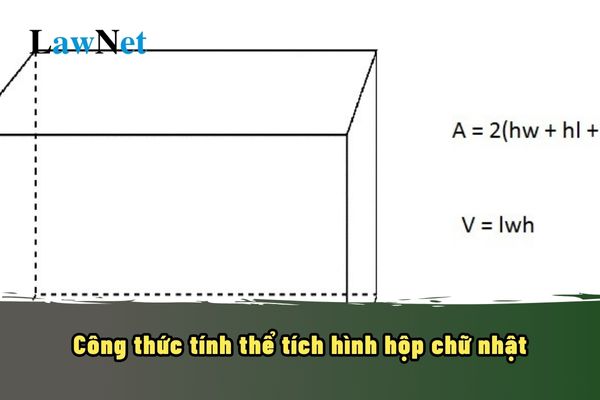What is the formula for calculating the volume of a rectangular prism? Is the application of information technology required in assessing primary school students' training and learning results in Vietnam?
What is the formula for calculating the volume of a rectangular prism?
The formula for calculating the volume of a rectangular prism is a topic in Grade 5 Mathematics.
To calculate the volume of a rectangular prism, we use the following formula:
V = a x b x c
*Where:
V: Is the volume of the rectangular prism.
a: Is the length of the rectangular prism.
b: Is the width of the rectangular prism.
c: Is the height of the rectangular prism.
*In other words:
The volume of the rectangular prism is the product of its length, width, and height.
Example:
If a rectangular prism has a length of 5cm, a width of 3cm, and a height of 2cm, then its volume will be:
V = 5cm x 3cm x 2cm = 30 cm³
*Note: The information regarding the formula for calculating the volume of a rectangular prism is for reference purposes only./.

What is the formula for calculating the volume of a rectangular prism? Is the application of information technology required in assessing primary school students' training and learning results in Vietnam? (Image from the Internet)
Is the application of information technology required in assessing primary school students' training and learning results in Vietnam?
According to the provisions in Clause 2, Article 22 of the Charter of Primary Schools issued together with Circular 28/2020/TT-BGDDT:
Assessment of students' training and learning results
...
3. For other educational institutions implementing the primary school education program, students who complete the primary education program according to the Minister of Education and Training's regulations are certified in their academic records by the head of that educational institution. For disadvantaged students without access to school, attending other institutions in the area, or those who return from abroad, the primary school principal organizes an assessment according to regulations and certifies program completion if the student meets the requirements.
4. Information technology is applied in assessing students' training and learning results following a roadmap appropriate to the practical conditions of the educational institution.
Thus, according to the above regulations, assessing primary school students' training and learning results will require the application of information technology. However, it must follow the roadmap appropriate to the practical conditions of the educational institution.
What are the 05 duties and 05 rights of primary school students in Vietnam?
The duties of primary school students are specified in Article 34 of the Charter of Primary Schools issued together with Circular 28/2020/TT-BGDDT:
- Study and train according to the education plan and school regulations; have self-discipline in learning and training to fully develop qualities and capabilities according to the objectives of the primary education program.
- Fulfill learning tasks effectively; know how to self-learn under the guidance of teachers; participate actively in experiential activities and apply learned knowledge to real-life; exercise and maintain personal hygiene.
- Be respectful to parents, and grandparents; be courteous to teachers and elders; be united, loving, and help friends, younger siblings, the elderly, the disabled, and those in difficult circumstances.
- Comply with regulations, protect school and public property; adhere to traffic safety rules; maintain cleanliness and protect the environment.
- Contribute to activities of building, protecting, and promoting the traditions of the school and local community.
The rights of primary school students in Vietnam are stipulated in Article 35 of the Regulations issued together with Circular 28/2020/TT-BGDDT:
- Right to learn
+ Primary school students are educated and study for comprehensive development and to best promote one's potential; to study at a school, class implementing the primary education program conveniently located for them within the residential area.
+ Students may choose their school or transfer to another school outside their residential area if the school can accommodate them.
+ Primary education-aged students returning from abroad, children of foreigners studying, and working in Vietnam, and children due to difficult circumstances without schooling may be assessed by the principal for appropriate class placement if they wish to transfer to a primary school.
+ Disabled students are entitled to inclusive education in a primary school; conditions must be ensured for their study and practice; they are taught and assessed according to their individual education plan.
+ Students may shorten the time to implement the program, study at an age higher than the prescribed age, extend study time, or repeat grades.
+ Students with good physical condition and early intellectual development may skip grades within the school level. The procedure for consideration in each specific case is as follows:
Parents or guardians submit a request to the school.
The school principal establishes a survey and advisory council, including the principal or vice-principal and the Parent Committee; the student's current class teacher, the higher class teacher, health staff, and the leader of Ho Chi Minh Young Pioneer Organization.
Based on the survey results from the advisory council, the principal completes the documents and reports to the Head of the Division of Education and Training for decision.
+ Students with limited academic results who have been directly guided and helped by teachers, parents, or guardians but still haven’t completed learning tasks; depending on the uncompleted level of tasks, teachers report to the principal for decision on grade promotion or retention and decide with the family on suitable educational measures.
- Right to protection, care, respect, and equitable treatment; assured legitimate rights and interests; fully informed about their learning and practice progress; ensured conditions of time, facilities, hygiene, safety for study, and practice.
- Right to participate in activities that develop personal abilities; express opinions and personal wishes.
- Right to receive scholarships and enjoy social policies according to regulations.
- Right to enjoy other rights as prescribed by law.

